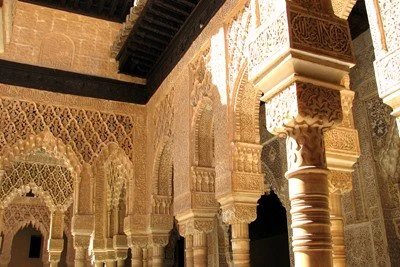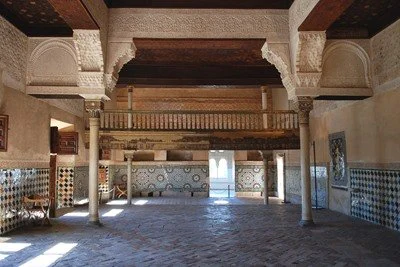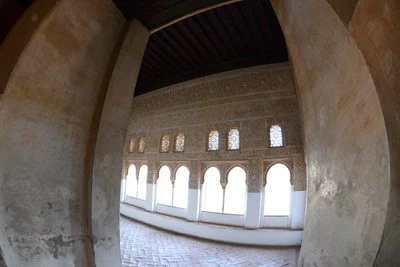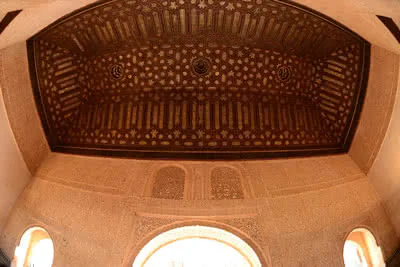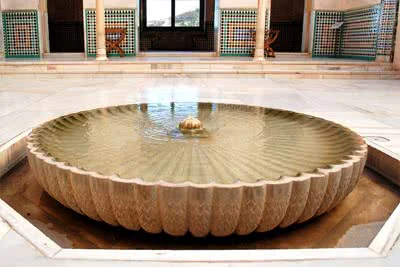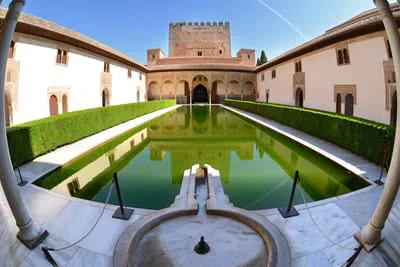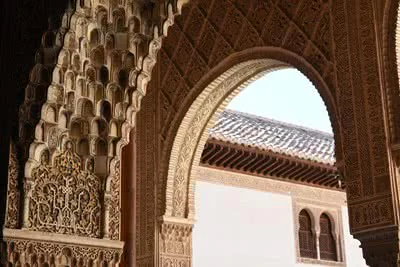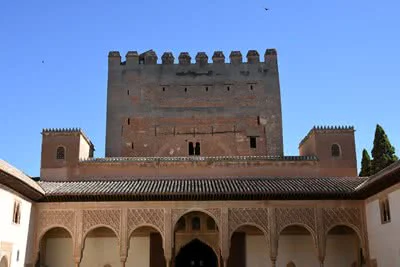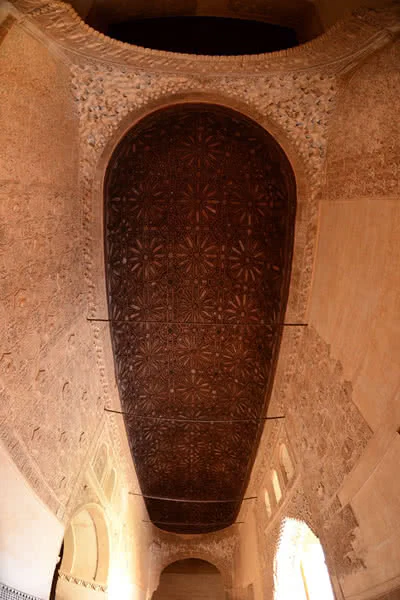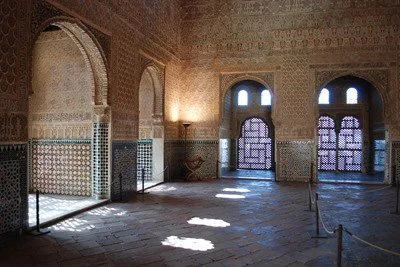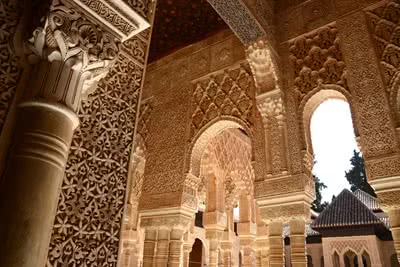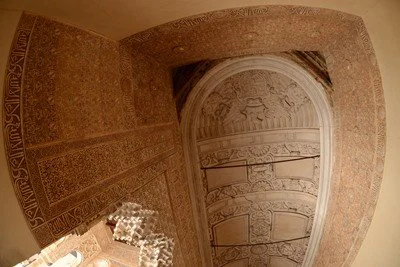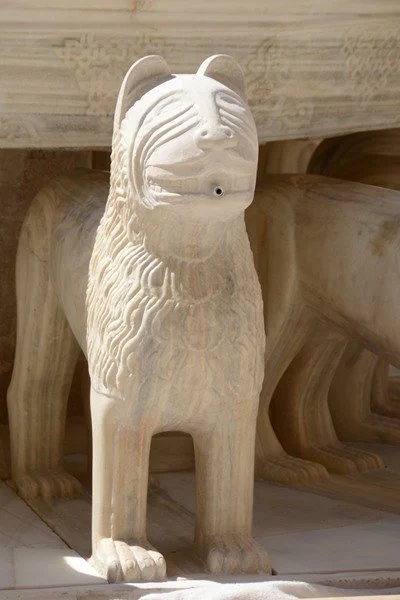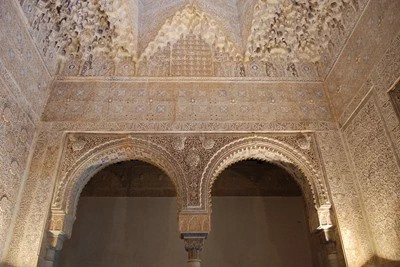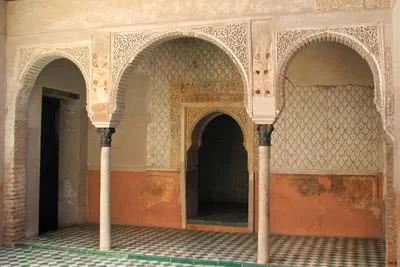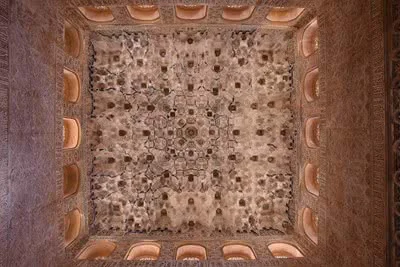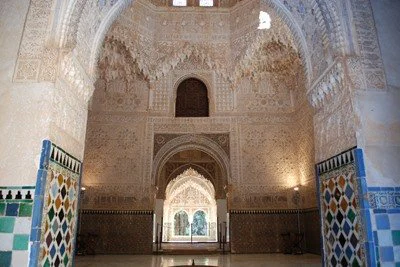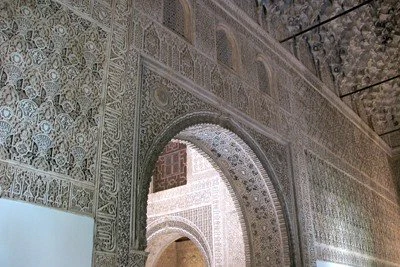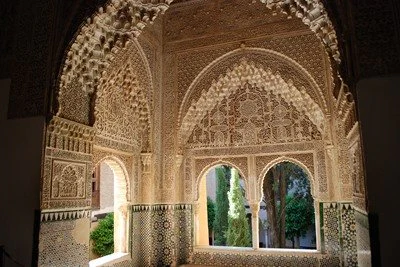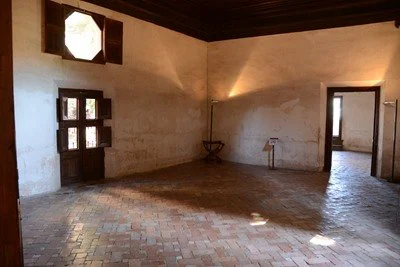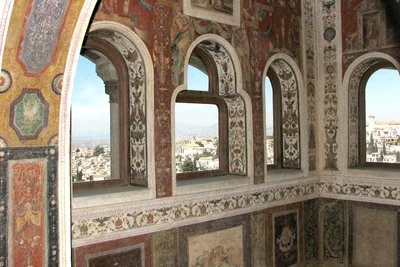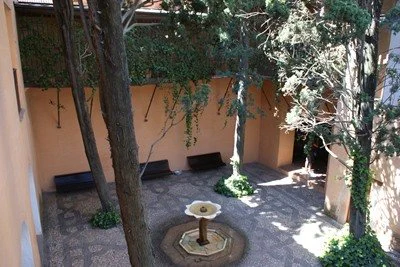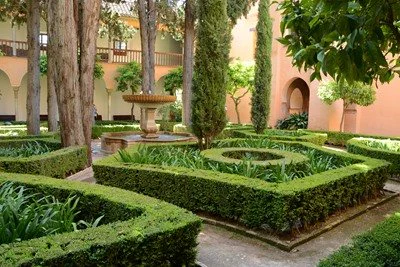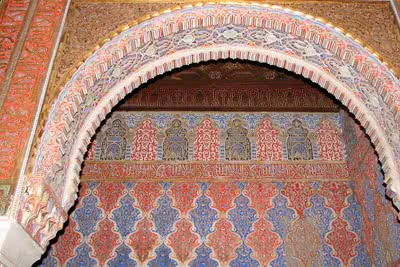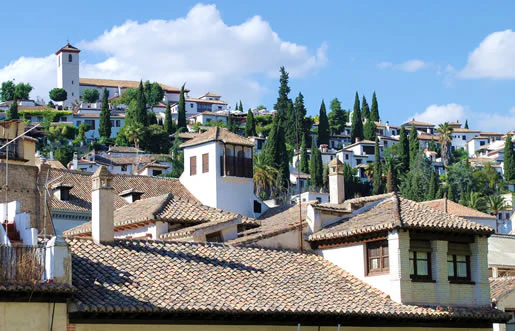Nasrid Palaces
Nasrid Palaces
Mohammed ben Al-Hamar (Mohammed I) was the first king to move to the Alcazaba and no records about a new palace being built are kept until those of Abu l-Walid Ismail. Only the Mexuar is now left because Yusuf I destroyed it completely. He started some improvements in the Comares Tower, the Court of the Myrtles and the Baths. These improvements were finished by Mohammed V, who added them all to the Mexuar, extended the gallery that would later be called Machuca and constructed the Palace of the Lions.
The Mexuar
It is difficult to know how the Mexuar was originally built, as the multiple restorations and reconstructions carried out until today do not let us know how its chambers were. The eastern section still survives from the series of chambers located next to the Tower of Mohammed I.That section is now known as «Mexuar».
Oratory
Located at the back of the Mexuar, was restored in 1917, as it was in a terrible state of repair due to the explosion of a magazine in the valley of the river Darro in 1590.
Gilded Room
The Gilded Room is so called because of the painted Mudejar style of its coffered ceiling. It as built by order of Mohammed V and belongs to the Comares Palace.
Patio of the Gilded Room
This small patio between the Mexuar and the Gilded Room.
Court of the Myrtles
The Court of the Myrtles has received different names throughout time. Its current name is due to the myrtle bushes that surround the central pond and the bright green colour of which contrasts with the white marble of the patio. It was also called the Patio of the Pond or the Reservoir.
Comares Palace
It was the official residence of the king and it comprises several rooms that surrounded the Court of the Myrtles. Some examples are the Hall of the Boat and the Hall of the Ambassadors inside the Comares Tower.
Comares Tower
The Comares Tower is the highest tower in the Alhambra. The Hall of the Ambassadors and the Hall of the Boat are located inside the tower. The leyend says that the Council that decided to surrender the city of Granada to the Catholic Monarchs took place inside this tower and the leyend also says that inside this tower, Christopher Columbus convinced the Catholic Monarchs to give their approval to his expeditions to the Indies towards the West.
Hall of the Boat
From the northern gallery of the Court of the Myrtles, visitors may enter into the Hall of the Boat. The origin of its name is the Arabic word "baraka", which means blessing and which degenerated into the Spanish word barca, which means boat.
Hall of the Ambassadors
This is the most majestic hall of the palace, where the throne was and where official receptions took place. According to Fernández-Puertas, the ceiling is a representation of the Seven Heavens of the Islamic Paradise, with God's throne on the eighth heaven. The hall is completely covered by decorative inscriptions: niches, arches, walls and dressing rooms are all covered by poems.
Palace of the Lions
This palace comprised the private chambers of the royal family. The Palace of the Lions comprises a central patio (Patio of the Lions), from the central patio you may access: the Hall of the Mocarabes to the west, the Hall of the Kings to the east, the Hall of the Two Sisters, the Hall of the Ajimeces and Daraxa's Mirador to the north and the Hall of the Abencerrajes and the Harem to the south.
Hall of the Mocarabes
It is the entrance to the palace of the lions and it was so called because of the vault of mocarabes that covered it, but which was pulled down due to the explosion of a powder magazine in 1590.
Patio of the Lions
This patio was built by order of Mohammed V, its ground plan is rectangular and it is surrounded by a gallery in the style of a Christian cloister. The gallery is supported by 124 white marble columns with fine shafts. It is so called because of the twelve lions that throw jets of water and which are part of the fountain in the middle of the patio.
Hall of the Abencerrajes
The Hall of the Abencerrajes is located in front of the Hall of the Two Sisters. It is so called because it is said that the Abencerrajes knights were there beheaded.
Harem
Harem was the king's home. Currently, only kept the patio of the Harem. You may access the Harem going through a corridor with a mirador to the Patio of the Lions.
Hall of the Kings
This place is called Hall of the Kings because of a painting on the central dome. It was also called Justice Hall and Court (Tribunal) from the 18th century.
Hall of the Two Sisters
The hall of the two sisters was so called because of two big twin marble flagstones that are part of the floor. The hall connects with the Emperor's Chambers and, through a balcony, with the Gardens of the Partal.
Hall of the Ajimeces
The Hall of the Ajimeces is so called because of two twin balconies on its north wall, which overlook the garden. The hall connects with the Hall of the Two Sisters and with Daraxa's Mirador.
Daraxa's Mirador
From the Hall of the Ajimeces you enter into Daraxa's Mirador. The inside of the mirador is a rectangular little room, with two lateral arches and a double arch at the entrance looking at Daraxa's Patio.
The Emperor's Chambers
These chambers comprise 6 halls. Two of them are located between the Patio of the Wrought Iron Grille and Daraxa's Garden. The other four halls, located to the north of Daraxa's Garden, are known as Washington Irving chambers, because the American writer lived there in 1829, when he visited Granada. The ceilings and the chimneys were made by Pedro Machuca. The emperor or his family never lived in these chambers.
Queen's Dressing Room
The Queen's Dressing Room, also known as Boudoir or Mirador, was built around the year 1537 at the top of Abu l-Hayyay's Tower and it is so called because the Empress Isabel, Charles V's wife, lived there. This tower was also called the «Tower of the Stove». The fresco paintings are of interest, especially the ones representing Charles V's campaign to Tunisia in 1535.
Patio of the Wrought Iron Grille
The Patio of the Wrought Iron Grille is so known because of the wrought iron grille that is on the southern wall.
Daraxa's Garden
Daraxa's Garden was also called Garden of the Orange Trees and Garden of the Marbles. The patio is demarcated by Daraxa's Mirador and the Hall of the Two Sisters to the south, by the Emperor's Chambers to the north and by the galleries built by the Emperor to the east and the west. The big central marble fountainwas made with the big basin that was in the Patio of the Gilded Room. To the south of the patio, there were the basements of the Hall of the Two Sisters, which form a series of rooms surrounding the Hall of the Secrets.
Baths
The Baths were built following the model of Roman thermal baths. The Hall of the Beds is the first chamber that you will find when you enter the baths, this room was where people undressed before going into the bath. The next chamber is the cold chamber. The central hall is the warm hall, which is connected with the other halls by arches. Finally there is the steam hall, which was the hot hall of the bath.
